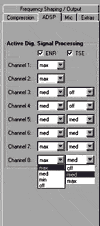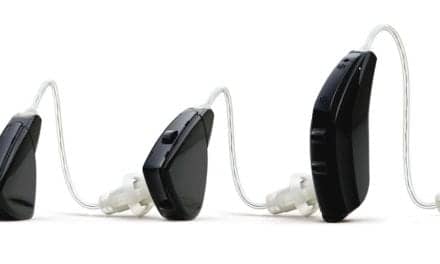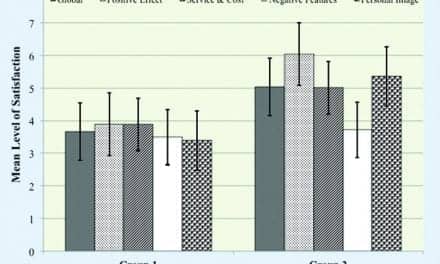Recently, a beta clinical trial was conducted on a new line of digital devices, the Beltone Oria, which incorporates a 12-band overlapping compression system. As with previous Beltone products, the fitting algorithm of this device is based on the Beltone Adaptive Fitting Algorithm (BAFA)1 system, utilizing a curvilinear compression strategy whereby the compressing kneepoints are variable depending on prescribed gain for soft, normal, and loud sounds. Three different time constants are offered with “normal” (ie, attack time of 30-50 ms; release time of 125-300 ms) as the recommended choice.
A new Gain Explorer system automatically adjusts the system to prevent feedback. The new line also offers a modulation base noise reduction system within each of the 12 bands, for a more precise method of reducing background noise when detected within the band. All of the devices except the CIC can be programmed with up to four programs.
Beta Clinical Trial
To validate patient benefit with this new technology, Beltone completed an extensive Beta trial at 16 Beltone offices across the US. A total of 74 subjects were fit with CICs, mini-canals, ITCs, or ITEs. The dispensing professionals were instructed to follow a formal 3-session protocol that included various questionnaires and speech testing. (Author’s note: Dispensing professionals were instructed to recruit subjects for the study and not patients, the distinction being that subjects are testing a product for its benefits without the “pressure” of buying. Subjects were not told the price of the instrument nor were they under any obligation to purchase the devices.)
Protocol: Subjects were required to attend at least three sessions following the qualification evaluation and taking of impressions. At the initial session, subjects were given the Abbreviated Profile of Hearing Aid Benefit (APHAB) for unaided hearing and their current hearing devices. They were then fit with the new instruments. Fine-tuning was completed by various means with a majority of the dispensing professionals using the Beltone AVE™ system1 or Live Speech Mapping via the Med-Rx OtoWizard. At the second session, subjects were tested with real ear measurements or functional gain. Additional questionnaires and any fine-tuning were also completed. The final session incorporated speech testing in background noise, APHAB, and a final questionnaire.
.gif)
Subjects: Seventy-four subjects participated in the beta trial of which 71 subjects completed the protocol. The average age of the participants was 71 years (range: ages 40-94). The average experience time of using hearing instruments was 9.5 years. Forty-six subjects were male and 28 were female. All but one subject was binaurally fit. All subjects were previous hearing aid users, with 62% being previous Beltone hearing instrument owners, 24% previous competitive instrument owners, and 14% unreported/ unknown. On average, subjects exhibited a moderate to severe sloping sensorineural hearing loss (Figure 1). Invisa (CIC) subjects, on average, had comparatively less low frequency hearing loss and more high frequency hearing loss.
.gif)
Objective Results: Speech perception was evaluated with noise using a recorded monosyllabic word list presented at 65 dB SPL with a +10 SNR (speech and noise were presented from 0° azimuth), with the Beltone AudioExpert CD used for this testing. The following conditions were tested: unaided, with own devices, Program 1 (BAFA), and Program 2 (BAFA/speech-in-noise). Mean results indicate that subjects performed better with the Oria instrument compared to their own devices or in the unaided condition (Figure 2). As expected, subjects performed similarly with Program 1 and Program 2.
Rating Questionnaire: Subjects were asked to rate the performance of their own hearing devices at the first session, and then rate the test devices at the final session using the same questionnaire. The rating scale ranged from 1-10, with “1” representing the poorest rating and “10” the best rating. The questionnaire was divided into the following eight categories: 1) Subject’s ability to understand speech in quiet; 2) Subject’s ability to understand speech in noise; 3) Sound quality; 4) Ease of use; 5) Feedback; 6) Wind noise; 7) Telephone; and 8) Overall satisfaction. Figure 3 illustrates the mean ratings for the various categories for the Oria and the subjects’ own devices. Subjects rated the Oria as providing significant benefit for all of the categories (p<.005 for the quality rating and p<.0005 for all other categories) compared to their own devices (Figure 3).
Figure 3. Subjects’ rating of questionnaire relative to listening situations.
APHAB: Subjects completed the APHAB, rating both unaided performance and performance with their own hearing aids prior to being fit with the test devices. At the final visit of the study, they also completed the APHAB for the test devices. Figure 4 demonstrates these mean APHAB benefit scores. As indicated in the graph, subjects perceived more benefit on average for all of the categories: Ease of Communication (EC), Reverberation (RV), Background Noise (BN), and Aversiveness (AV) with the Oria hearing aids compared to their own devices. Subjects rated Ease of Communication with the test devices as providing significant benefit (paired t-test for independent samples with two tails, p<.01).
.gif)
Final Questionnaire: Patients filled in a general questionnaire at the conclusion of the beta trial:
1. On a scale of 1 to 5, where "5" is very satisfied and "1" is very dissatisfied, how would you rate your overall satisfaction with the Beta hearing aids? Average rating: 4
2. What do you like most about the Beta hearing aids? Reoccurring comments included: Ability to hear in crowded room/restaurant; the warning about the batteries going dead; natural hearing; easier to speak due to less feedback; own voice not distorted; quiet, forget they are in ears; no volume adjustment needed; no feedback; more consistent/comfortable sound; ability to have multiple programs; and no volume control.
3. What do you like least about the Beta hearing aids? Reoccurring comments (not included here are conditions that would be fixed by the dispensing professional, by use of a VC, etc): Price/cost; feedback on phone, intermittent feedback, echo; no “off” switch; bigger size than own device; sound of own voice (own voice too loud/difficult to project); and background noise.
Conclusion
Hearing aid users rated the Oria as providing significantly more overall satisfaction compared to their own devices. In particular, subjects rated the device as providing significantly more benefit when in quiet, in noise, for sound quality, on the telephone, and as having less feedback problems/less wind noise.
| This article was submitted to HR by Laurel Olson, MA, director of clinical research at GN ReSound NA/Beltone Electronics, Chicago. Correspondence to HR or GN ReSound NA Research Audiol. Grp/Beltone Electronics, 4201 W Victoria St, Chicago, IL 60646-6718; email: [email protected]. |
References
1. Russ D, Robinson J. Beltone’s adaptive fitting algorithm: Combining loudness normalization and loudness equalization to achieve targe gain. Found at: www.audiologyonline.com.
2. Robinson J, Russ D, Siu B.The effect of a multimedia fitting tool on final gain settings. Hearing Review. 2002; 9(3):42-45.

.gif)
.gif)



